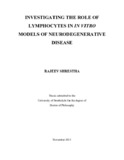Please use this identifier to cite or link to this item:
http://archive.nnl.gov.np:8080/handle/123456789/430| Title: | Investigating the role of lymphocytes in in vitro models of neurodegenerative disease |
| Authors: | Shrestha, Rajeev |
| Keywords: | Lymphocytes Central nervous system Neurodegenerative diseases |
| Issue Date: | 25-Feb-2018 |
| Abstract: | The CNS was until recently considered an ‘immune-privileged’ area. However, evidence now exists that inflammation and immune cells play key roles in several inflammationrelated CNS disorders. Despite this, the exact role of immune cells under physiological and pathophysiological conditions remains elusive. Hence, I sought to investigate the role of lymphocytes using in vitro models of neurodegenerative disease in organotypic slice cultures. Organotypic cortico-hippocampal slice cultures (OSCs) were prepared from mice (4-7 days old) and maintained for 13-15 days in vitro. Neuronal death was assessed utilising propidium iodide (PI) fluorescence following either an excitatory insult (300μM Kainate (KA), 1hr) or oxygen-glucose deprivation (OGD; 30 mins) in the absence and presence of different lymphocyte preparations. Western-blotting and a pharmacological approach were implemented to investigate possible signalling pathways. Lymphocytes significantly reduced KA-induced toxicity and OGD-induced cell death under the present experimental conditions indicating a neuroprotective role for lymphocytes. In addition, conditioned media from lymphocytes were also neuroprotective against KA-induced toxicity and OGD-induced cell death. This finding suggests that lymphocyte-mediated neuroprotection is contact-independent. Furthermore, pre-treatment of OSCs with FAc, a glial cell metabolic inhibitor, abolished the observed neuroprotection in the KA model but not in the OGD model. In addition, western blotting revealed that in slices co-cultured with lymphocytes there is a significant reduction in the activity of ERK and p38 MAP kinase. The present data indicates that in two different models of neurodegenerative disease, lymphocytes are neuroprotective under my experimental conditions, an effect mediated, at least in part, by activation of astrocytes and an inhibition of MAP kinase signalling pathways. However, further work is needed to establish the involvement of microglia and other immune cells including macrophages and natural killer cells. |
| Description: | Thesis submitted to the University of Strathclyde for the degree of Doctor of Philosophy, 2011 |
| URI: | http://103.69.125.248:8080/xmlui/handle/123456789/430 |
| Appears in Collections: | 600 Technology (Applied sciences) |
Files in This Item:
| File | Description | Size | Format | |
|---|---|---|---|---|
| PhD Thesis_Rajeev Shrestha_2011.pdf | 10.07 MB | Adobe PDF |  View/Open |
Items in DSpace are protected by copyright, with all rights reserved, unless otherwise indicated.